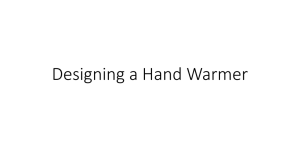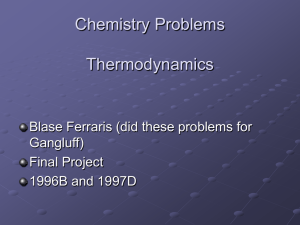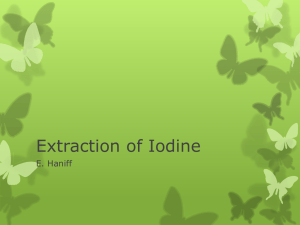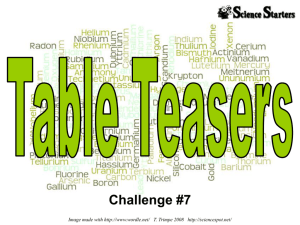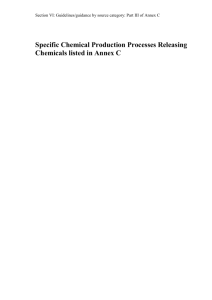Chemical Equations
advertisement
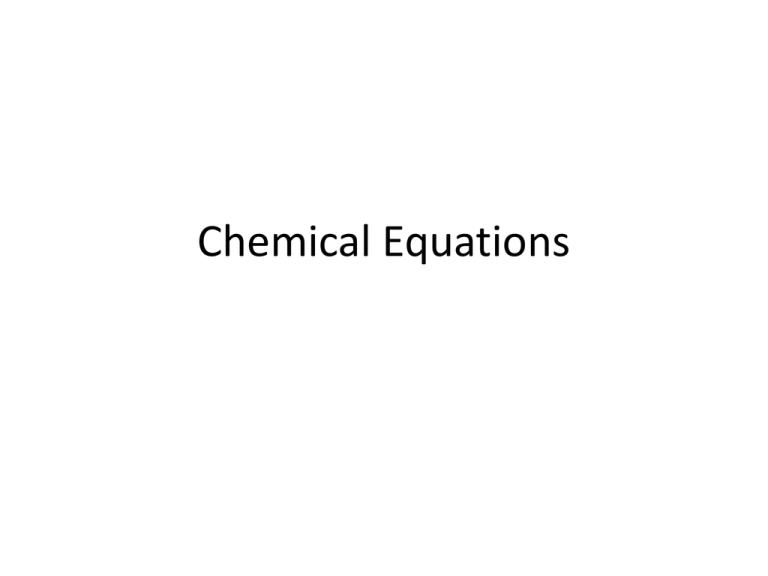
Chemical Equations What is a reaction? • A chemical reaction occurs when the bonds between the outermost parts of atoms are formed or broken • Chemical reactions involve changes in matter, the making of new materials with new properties, and energy changes • The equation for a reaction shows the reactants and products as well as their relative amounts within the reaction Reactants • The reactants in a chemical equation are the atoms that react to form a different substance • They will typically be on the left hand side of the equation • In word equations the reactants will also typically be mentioned first Example • Iodine crystals react with chlorine gas to produce iodine trichloride. • The reactants are iodine crystals and chlorine gas I2 and Cl2 Products • The products in a chemical reaction are what is formed from the reaction • In a chemical equation they will typically be on the right • In word equations they are usually listed after the reactants to show what the reactants “created” (created is in quotes for a reason) Example • We will use the same previous example: Iodine crystals react with chlorine gas to produce iodine trichloride. • The product in this reaction would be iodine trichloride ICl3 Word Equations • When writing a word equation, and eventually a chemical equation, you will place reactants on one side and products on the other • Iodine crystals react with chlorine gas to produce iodine trichloride. In our example we would have end up having: Iodine + Chlorine Iodine trichloride • The plus sign indicates that two items on that particular side of the equation are separate but within the same reaction • The arrow indicates the direction of the reaction • There are also situations where there are two arrows pointing in the opposite directions, but we are not going into those yet Practice 1. Sodium metal and chlorine gas react to form sodium chloride 2. Iron metal and chlorine gas yield iron III chloride 3. Water is formed when hydrogen and oxygen gases react 4. Sodium chloride and lead II nitrate react to produce lead II chloride and sodium nitrate Answers 1. Sodium + Chlorine Sodium Chloride 2. Iron + Chlorine Iron III Chloride 3. Hydrogen + Oxygen Water (dihydrogen monoxide) 4. Sodium Chloride + Lead II Nitrate Lead II Chloride + Sodium Nitrate Real chemical equations • Chemists do not write out the words each time for two reasons: • First, its time consuming. Using shorthand symbols like the chemical symbols we have been using for the last few months is quicker • Second, the chemical symbols tell us more about the molecule and make spotting reaction types often easier than when using words • So in order to write a word equation as a chemical equation, all you simply have to do is replace the words with their respective chemical symbols • Remember that there will be ionic compounds, covalent compounds, and there will be polyatomic ions present in many equations as well. Do not forget how to identify them and when to use parenthesis! Example • Iodine crystals react with chlorine gas to produce iodine trichloride. • The word equation was: Iodine + Chlorine Iodine trichloride • This means our chemical equation will be: I2 + Cl2 ICl3 Our practice examples 1. Sodium + Chlorine Sodium Chloride 2. Iron + Chlorine Iron III Chloride 3. Hydrogen + Oxygen Water (dihydrogen monoxide) 4. Sodium Chloride + Lead II Nitrate Lead II Chloride + Sodium Nitrate Answers 1. 2. 3. 4. Na + Cl2 NaCl Fe + Cl2 FeCl3 H2 + O2 H2O NaCl + Pb(NO3)2 PbCl2 + NaNO3 What looked Wrong? • There was something off about those equations • Did you see what it was? • Look again. Answers 1. 2. 3. 4. Na + Cl2 NaCl Fe + Cl2 FeCl3 H2 + O2 H2O NaCl + Pb(NO3)2 PbCl2 + NaNO3 • Did you see it that time? • What was it? Balancing an equation • The law of conservation of matter states that matter can neither be created nor destroyed • This means that the previous chemical equations were not correct due to their lack conservation • Some of them had one or two different amounts of the same elements on the opposite sides of the SAME EQUATION! • This cannot happen • When balancing an equation you can only manipulate the coefficients • Fe2O3 + 3 CO 3 CO2 + 2 Fe • The underlined numbers are the coefficients • You CANNOT CHANGE THE SUBSCRIPTS! What is on one side must be on the other • This means you cannot have sodium on one side and not on the other • Back to our group example: Iodine + Chlorine Iodine trichloride Which became: I2 + Cl2 ICl3 Steps to Balancing Equations 1) Assemble the correct formulas for all the reactants and products, using “+” and “→” 2) Count the number of atoms of each type appearing on both sides 3) Balance the elements one at a time by adding coefficients (the numbers in front) where you need more - save balancing the H and O until LAST! (hint: Some prefer to save O until the very last) 4) Double-Check to make sure it is balanced. Balance it • I2 + Cl2 ICl3 • First, we’ll balance out the chlorines by adding a coefficient • I2 + 3 Cl2 ICl3 • Still not balanced yet. We have six chlorines in the reactant, but only 3 in the products. Add another coefficient • I2 + 3 Cl2 2 ICl3 Now count the atoms • Reactants: 2 I and 6 Cl • Products: 2 I and 6 Cl Balanced! Your Turn 1. 2. 3. 4. Na + Cl2 NaCl Fe + Cl2 FeCl3 H2 + O2 H2O NaCl + Pb(NO3)2 PbCl2 + NaNO3 Answers 1. 2. 3. 4. 2 Na + Cl2 2 NaCl 2 Fe + 3 Cl2 2 FeCl3 2 H2 + O2 2 H2O 2 NaCl + Pb(NO3)2 PbCl2 + 2 NaNO3


